Healing Through Art
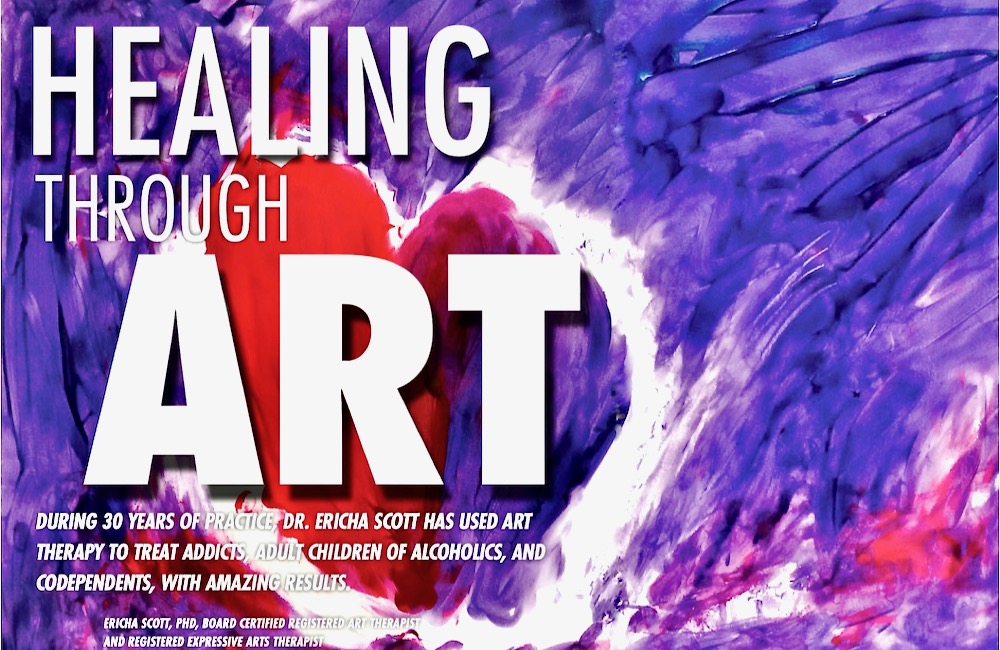
Author & Artist: Ericha Scott, PHD, Board certified registered art therapist and registered expressive arts therapist
During 30 Years Of Practice, Dr. Ericha Scott Has Used Art Therapy To Treat Addicts, Adult Children Of Alcoholics, And Codependents, With Amazing Results.
I am the daughter of a southern belle debutante who drank. The family secret is that I was born with multiple physical and developmental challenges due to an exposure to alcohol in utero. I had failed fourth grade and I was just about to fail it twice when I overheard my teacher whisper to my mother, “You know she really likes art, why don’t you give her art lessons?”
I can remember thinking that was a good idea. My mother hired a longhaired hippy who drank to teach me how to paint, and in doing so changed my life. By fifth grade I was reading at college level. While I cannot make a claim that the two are directly related, after decades of study, I would say yes: art helped me to read, or at least to care enough to read.
As a child, art woke my sleeping heart and mind. As a professional, I have been blessed to witness how art has wrought miracles similar to mine in the lives of my clients for past 30 years.
Today, I am an artist, a certified art therapist, and a licensed professional clinical counselor who uses art with clients inside the practice of psychotherapy. I would no longer have this tremendous passion for my work if I had not used art – all forms of art – as my cotherapist.
Personally, I use art for a myriad of reasons. There are times I am just a Sunday painter or photographer, and times that I am a professional artist and teacher. Other times, art is my lifeline, a way to express the inexpressible, like the death of my beloved husband and my grief about violence in the world.
All of that is to say, art is my medicine, my comfort, and my go-to for insight and meaning. Art facilitates my deepest and most accurate intuitions. It is for these reasons that art has become instrumental to my addiction and psychotherapy practice.
What is Art Therapy?
At the beginning of my career, a supervisor suggested that I incorporate art therapy into my practice. I am still slightly embarrassed to admit that I had to ask him, “What is art therapy?”
Now, after five more years of college, numerous credentials and recognitions, and a few publications in peer-review journals, I am still asking that question. Although it may be difficult to quantify, I have found that the power behind art therapy is undeniable.
The International Expressive Arts Therapy Association offers the most comprehensive definition: “The expressive arts combine the visual arts, movement, drama, music, writing and other creative processes to foster, deep personal growth and community development…. By integrating the arts processes and allowing one to flow into another, we gain access to our inner resources for healing, clarity, illumination, and creativity.”
I liken the multimodal processes of the creative arts therapies to cross training your brain and psyche, in a similar fashion to how athletes cross train their bodies for a marathon race.
WHO IS ABLE TO BENEFIT FROM ART THERAPY?
A client does not need to like art or have an innate talent to benefit from the creative arts therapies. Art therapy activities, provided by a licensed and certified art therapist, are able to be modified for any clinical population. Clients who engage in professional art therapy often find that the creativity accessed in session opens doors to creativity in other areas of their lives. Art therapy is particularly well suited for those who struggle with addiction.
Why Art Therapy?
The visual arts help people see their lives, their problems, and even their defenses from a different point of view. I have often observed a client with a history of sexual abuse paint the abuse and a long history of gynecological problems on a life-sized body tracing before saying, “I never connected my sexual abuse to my health problems before.”
There are times that words are not enough. There are times that memory is encoded in image, not just language. There are times that an experience has only a few words attached to it and therefore cannot be adequately described without an image. For example, consider how much less this article would mean to you without the visual images.
All art is a projection. This means that every art piece, whether representational or abstract, is a mirror of the self, which we manifest consciously and unconsciously. Art bypasses our frontal lobe verbal filters and cuts through to what is essential. Original art is able to represent our true nature, what happened to us, and our emotions, desires, and dreams.
Just as people tend to minimize the severity of an addiction (“I only had one drink”), people tend to minimize the severity of abuse and trauma in a similar fashion. With the support of a qualified art therapist, art can be a powerful and yet gentle intervention upon this type of cognitive distortion.
Art can also help people to realize the effects of their mental illness or addiction. Clients have said, “I wish I could have seen this drawing of mine twenty years ago, maybe I would have not relapsed,” or “I couldn’t grasp what I was hearing from my wife, until I saw my children’s drawings about how my addiction was affecting them.”
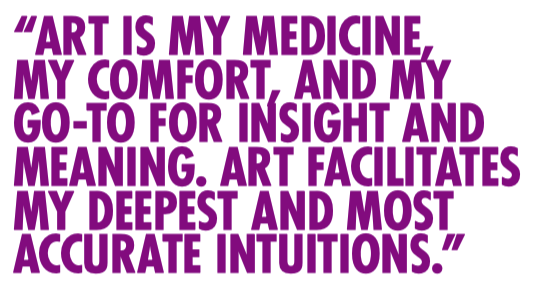
One wonderful quality about art as a healing tool is that it is accessible people can paint or draw with items that they have at home. Even doodling with a pen and paper can be healing. Because of this, people often question why they should do art therapy, rather than just making art on their own, or taking an art class.
For those who need help, the guidance of a professional offers great advantages. Consider this example: a hot shower can be therapeutic, but it certainly is not therapy. In addition, a hot shower is not benign – a person can be scalded if the temperature for the water is not set correctly. Similarly, as art class can be therapeutic, but it is not necessarily benign, especially if the art teacher tries to integrate psychological or subconscious symbolic processes.
A person who has been hurt, shamed, traumatized or left vulnerable from a mental illness or substance abuse can be triggered by visual images and then flooded with emotionally laden material in a way that is destabilizing. Conversely, important conflicts, issues, or memories can be re-repressed by techniques that reinforce cognitive defenses. These are a few reasons to seek a qualified art therapist who knows how to select timely and beneficial art interventions.
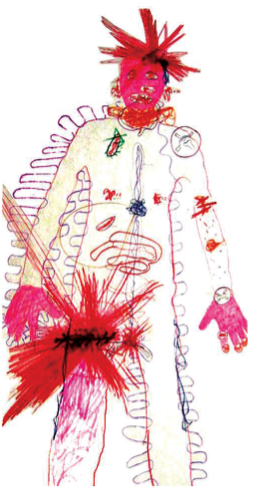
Self-Portraiture in Art Therapy
I have found that self-portraiture is one of the greatest tools in my repertoire of psychotherapeutic techniques. Self-portraiture, no matter the technique used, can help those with addiction establish and strengthen a recovery identity. Art therapy is also able to help a person realize a deeper level of recovery or the potential for relapse; to work through pain and grief; to develop self-love; and to connect with a higher power or God concept. Making a self-portrait is able to helps anchor, reinforce, and manifest positive dreams a person wants to create for his or her future life.
While there are many ways to draw the self for therapeutic purposes, I like to use blind contour self-portraiture. This technique focuses all attention on the artist’s image in the mirror, while avoiding looking at the drawing paper or pen. This helps the viewer bypass stereotypical assumptions of reality and see with more clarity. This drawing process, especially when used in art therapy, helps clients see objects and circumstances as they are, not just as we imagine or want them to be.
The Power of a Body Map
As I incorporated self-portraiture into my therapy practice, I continued to observe the important ways that perception or misperception of the body can affect clients.
Even so, I was a bit surprised in 1988, when an adult woman in treatment for codependency told me that while she was cooking she felt as if she could barely reach the stove, although logically she knew this was not accurate. This distortion of height is associated with regression, a return to a prior level of functioning or sense of self.
I asked if her parents had marked her height on a door jamb when she was growing up. She said “Yes.” Then I asked if they ever marked her full adult height. Frowning, she said, “No”. I asked if she would be willing to let me mark her height on the door to the counseling room. I made a simple mark, just at the top of her height. She stood back and what happened next surprised me. With great intensity she said, “Wow, I am really tall! I never knew that.”
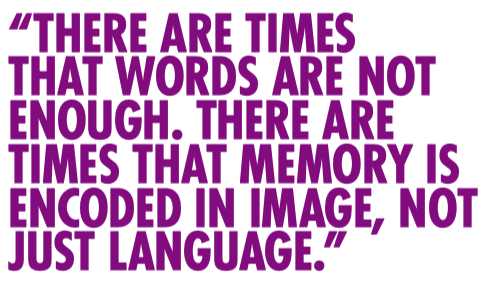
As I watched, it seemed as if this new insight became a moment of instant empowerment. Although she had been dutifully nurturing her inner child egostate in counseling sessions, she had not grasped the power of her adult presence until that moment.
Curious about what I had observed, I facilitated a similar process with many of my clients that week, and across the board almost all had a very positive response. One person, a male alcoholic who had previously acknowledged a history of the abuse of his own power, stood back, saw his adult height and became tearful. He said, “I am so big, I didn’t know… I could really hurt people.”
Within a few weeks, I decided that a better way to help people acknowledge cognitive distortion and feel an empowered sense of adulthood was via a body map, rather than a door jamb. Life-sized body maps had been used previously in the counseling field with eating disorder patients to address body dysphoria, but not to address regression to childhood because of trauma.
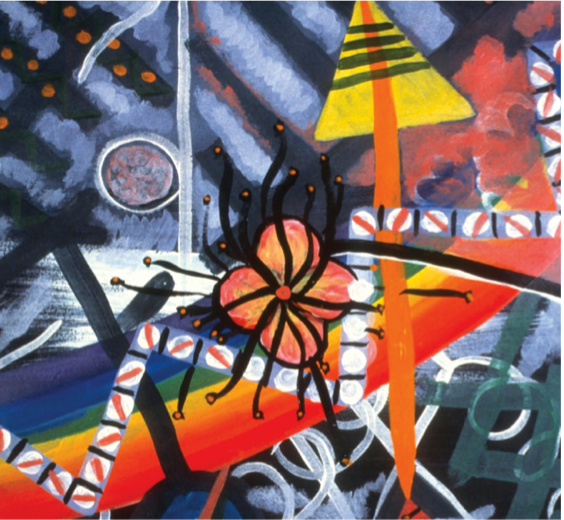
A few months later, I offered a workshop on healing the inner child to 40 drug and alcohol counselors. Using the life-sized body tracing, I facilitated an inner-child meditation and asked each person to draw his or her adult self nurturing the inner child. This group of professionals spoke of empowerment, but also how they had not truly acknowledged the impact of their childhood trauma on their own well-being. It appeared to me that the drawings broke through denial in a gentle fashion, via viewing the visual image and the experience of kinesthetic movement (gross motor skills) while creating it.
Today I use the body map, which I now refer to as a life-sized silhouette mandala, with almost every client. The process of painting a life history and sensory perceptions as it effects the body is essential for those who are addicts, and for those who live with them. I refer to the body map as a mandala, because like the circular mandala, but in a more concrete fashion, the life-sized silhouette mandala represents the totality of self.
Symbols and the Interpretations Myth
People often ask me about the interpretation of symbols in art. It is true that there are universally accepted meanings of symbols. At the same time, symbols are very personal and specific to each person’s history and culture. Because of this, rather than “interpreting” symbols, I use my knowledge of the cross-cultural meaning of symbols to form open-ended questions for the client. It is the client who is the expert on the meaning of their creative productions.
For example, I worked with an adult man who hated the color blue. For him, blue was a color that represented rage – not a common association. After some discussion, he revealed that his childhood bedspread had been blue. The man, who had a history of childhood sexual abuse, had not made the connection between his dislike of the color blue and his trauma history.
It is important for clients to sort out the meaning, projection and triggers to the symbols of their lives. Understanding these unconscious reactions can help the client arrive at a point of conscious choice with regard to the people, objects and even addictive substances they encounter. Yet clients do not have to sort out the meaning of their art and life alone. Instead, they engage in this vibrant and dynamic process with the support and guidance of an expert in art psychotherapy.
Does it Work?
We all know that insight alone is not curative – many people have died of a self-acknowledged addiction.
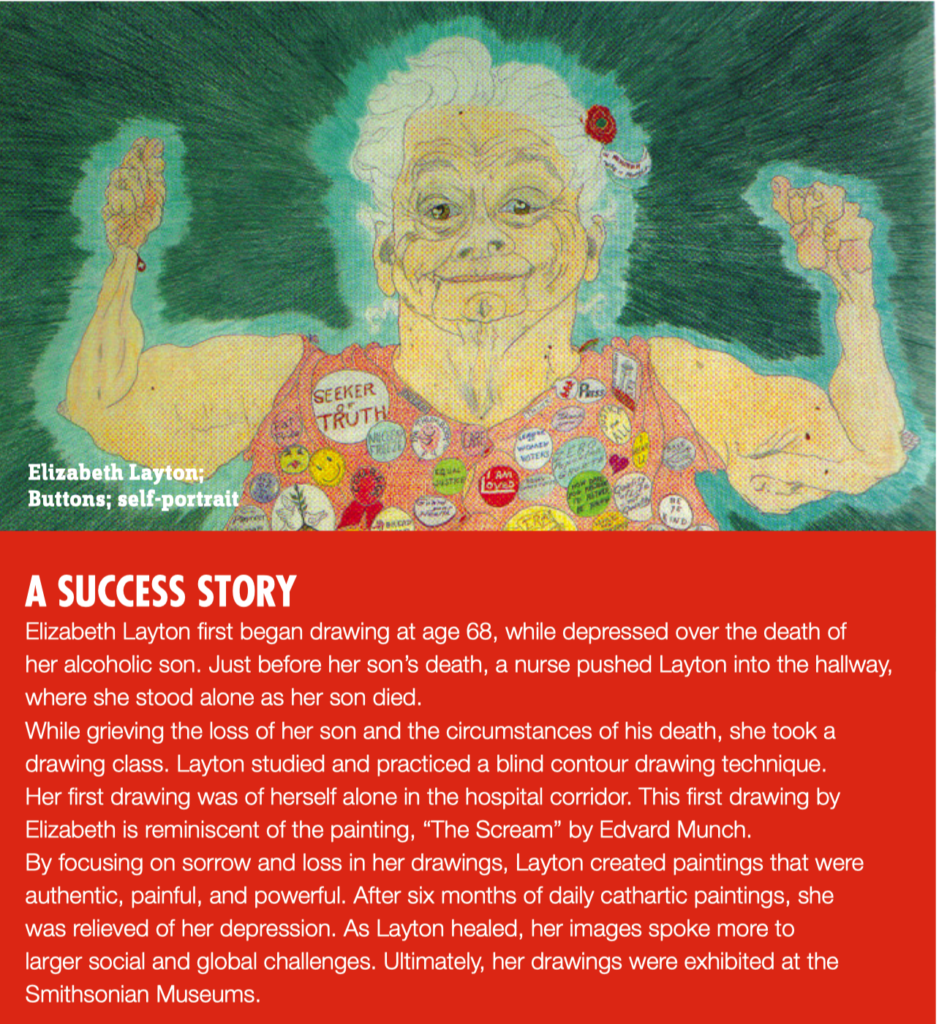
Yet neither therapy nor the 12 steps can begin to have a true healing impact until denial is broken. At that point of awakening, a person is better able to ask for and receive help. A painting is truly worth a thousand words when it comes to permeating the walls of denial.
Although the creative arts are not considered to be an evidence-based therapy due to the lack of large studies, there are a number of small and statistically sound studies that do reveal the efficacy of the art therapies. One study suggests that patients in residential treatment are more likely to remain in treatment until their treatment goals are finished if they are engaged in an art therapy process. Completing treatment goals is essential for long-term success, and art therapy can make that happen.
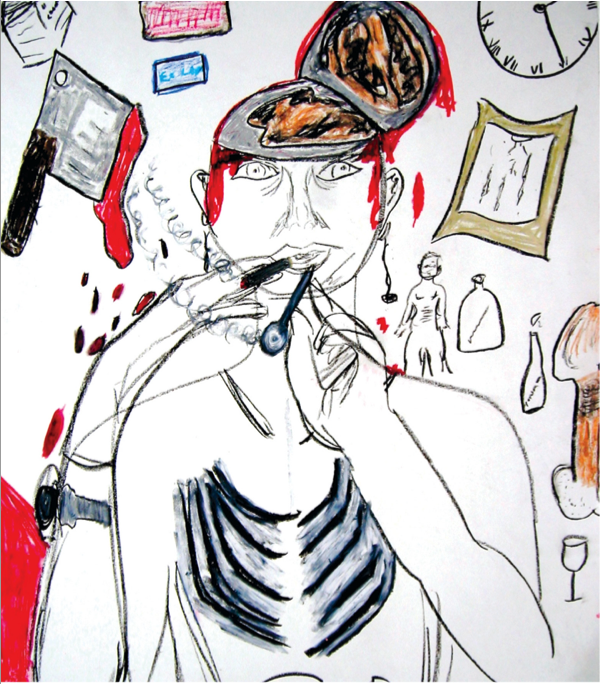
For more information, visit American Art Therapy Association at www.arttherapy.org or The International Expressive Arts Therapy Association at ieata.org.
E. Hitchcock Scott, PhD, LPCC917, NCC, LAADC; Board Certified Registered Art Therapist (ATR-BC); Registered Expressive Arts Therapist (REAT) has 30 years of professional experience working with those who have multiple addictions and complex trauma. She holds six licenses in four states. She has published research in peer review journals on self-mutilation by dissociative disordered individuals, her theory of creative arts therapy for trauma and addiction, and human slavery. Through multiple channels, Dr. Scott continues to contribute to the fields of art therapy, addiction and trauma with a deep sense of passion and commitment. She has a private practice on Point Dume in Malibu, and can be reached at www.drerichascott.com, [email protected], 310-880-9761.
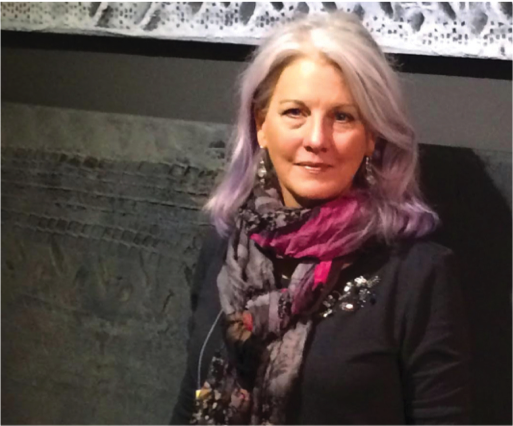
NOTE: All art submissions in this article are posted with a written authorization to release confidential information. The cases are disguised, meaning they are a conglomerate of several cases or important identifying information has been changed. Client information emerges from three decades of work and from a variety of locations across the United States and abroad.
Dr. Ericha Scott has worked with art therapy clients for 30 years. Photo credit Gail Carr Feldman, PhD
References:
Art Exhibition, Mirrors of the Mind 3: The Psychotherapist as Artist, Art Share LA, Los Angeles, CA, November 1 – 8, 2014; Mirrors of the Mind 3: The Psychotherapist as Artist, art exhibition catalogue, in press, Los Angeles County Psychological Association.
Lambert, D. (1995). The Life and Art of Elizabeth “Grandma” Layton. DRS Publishing: Waco, Texas.
Nichols, J. and Garrett, A. (1995). Drawing and Coloring for Your Life. Gingerbread Castle Publishers: Overland Park, Kansas.
Pizarro, J. (2004). The Efficacy of Art and Writing Therapy: Increasing Positive Mental Health Outcomes and Participant Retention After Exposure to Traumatic Experience. Art Therapy: Journal of the American Art Therapy Association, 21(1) 5-1
Scott, E. H. & Ross, C. J. (2006). Integrating the creative arts into trauma and addiction treatment. Journal of Chemical Dependency Treatment, 8, 2, pp. 207-226. doi.org/10.1300/J034v08n02_11.
Scott, E. H. (1999). The body as a testament: A phenomenological case study of an adult woman who self-mutilates. The Arts in Psychotherapy, 26, 3, pp. 149-164.
Springham, N. (2008). Through the eyes of the law: What is it about art that can harm people? International Journal of Art Therapy: Formerly Inscape, 13:2, 65-73, doi: 10.1080/17454830802489141.


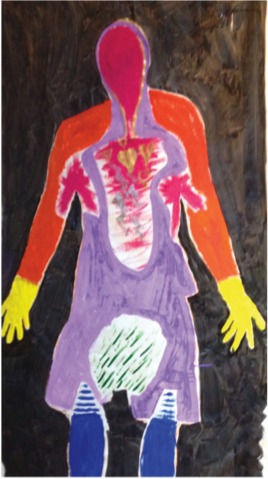


No responses yet